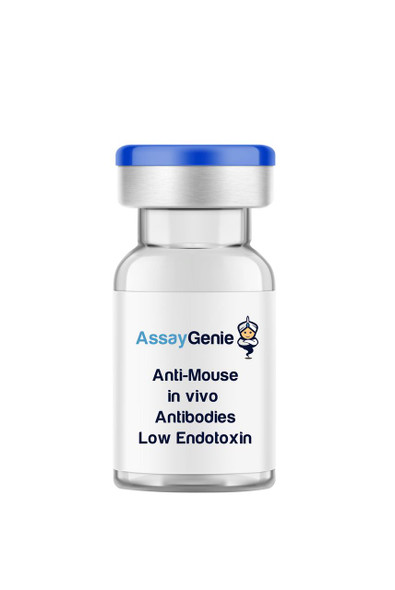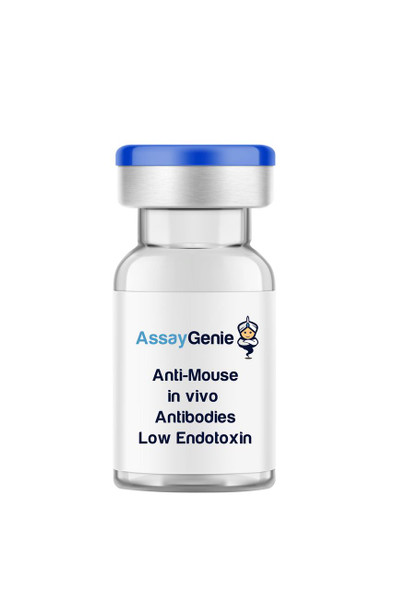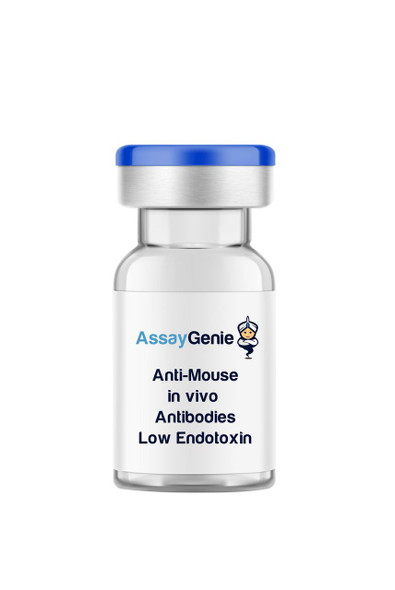Mouse Anti IL-6 Monoclonal Antibody In Vivo Antibody - Low Endotoxin (IVMB0363)
- SKU:
- IVMB0363
- Antibody Type:
- Functional-Grade In Vivo Antibody
- Disease Area:
- Inflammatory Diseases
- Disease Area:
- Autoimmune Disorders
- Clone:
- MP5-20F3
- Protein:
- IL-6
- Isotype:
- IgG1 k
- Reactivity:
- Mouse
- Synonyms:
- Interleukin-6
- IL6
- Anti-Mouse IL6
- Anti-Mouse IL-6
- BCSF
- Research Area:
- Immunology
- Innate Immunity
- Endotoxin Level:
- Low Endotoxin
- Host Species:
- Rat
- Applications:
- ELISA Cap
- ELISPOT
- FA
- In Vivo
- N
Description
| Product Name: | Mouse Anti IL-6 Monoclonal Antibody In Vivo Antibody - Low Endotoxin |
| Product Code: | IVMB0363 |
| Size: | 0.5 mg, 1 mg, 5 mg |
| Clone: | MP5-20F3 |
| Protein: | IL-6 |
| Product Type: | Monoclonal Antibody |
| Synonyms: | Interleukin-6, IL6, Anti-Mouse IL6, Anti-Mouse IL-6, BCSF |
| Isotype: | IgG1 k |
| Reactivity: | Mouse |
| Applications: | ELISA Cap, ELISPOT, FA, In Vivo, N |
| Formulation: | This monoclonal antibody is aseptically packaged and formulated in 0.01 M phosphate buffered saline (150 mM NaCl) PBS pH 7.2 - 7.4 with no carrier protein, potassium, calcium or preservatives added. Due to inherent biochemical properties of antibodies, certain products may be prone to precipitation over time. Precipitation may be removed by aseptic centrifugation and/or filtration. |
| Endotoxin Level: | <0.1 EU/µg as determined by the LAL method |
| Purity: | >95% by SDS-PAGE and HPLC |
| Product Preparation: | Functional grade preclinical antibodies are manufactured in an animal free facility using in vitro cell culture techniques and are purified by a multi-step process including the use of protein A or G to assure extremely low levels of endotoxins, leachable protein A or aggregates. |
| Applications: | ELISA Cap, ELISPOT, FA, In Vivo, N |
| Reactivity: | Mouse |
| Host Species: | Rat |
| Specificity: | Clone MP5-20F3 recognizes an epitope on mouse IL-6. |
| Concentration: | 1.0 mg/ml |
| Endotoxin Level: | <0.1 EU/µg as determined by the LAL method |
| Formulation: | This monoclonal antibody is aseptically packaged and formulated in 0.01 M phosphate buffered saline (150 mM NaCl) PBS pH 7.2 - 7.4 with no carrier protein, potassium, calcium or preservatives added. Due to inherent biochemical properties of antibodies, certain products may be prone to precipitation over time. Precipitation may be removed by aseptic centrifugation and/or filtration. |
| Purity: | >95% by SDS-PAGE and HPLC |
| Preparation: | Functional grade preclinical antibodies are manufactured in an animal free facility using in vitro cell culture techniques and are purified by a multi-step process including the use of protein A or G to assure extremely low levels of endotoxins, leachable protein A or aggregates. |
| Storage and Handling: | This Low Endotoxin Functional Formulation conjugate is stable when stored at 2-8°C. Do not freeze. For long term storage, aseptically aliquot in working volumes without diluting and store at –80°C. Avoid Repeated Freeze Thaw Cycles. |
IL-6 is a pleotropic 26 kD protein that can act as both a pro-inflammatory cytokine and an anti-inflammatory myokine, a form of cytokine produced in muscle cells that participates in tissue regeneration and repair, maintenance of healthy bodily functioning, and homeostasis within the immune system. IL-6 plays a part in the immune, endocrine, nervous, and hematopoietic systems, in addition to bone metabolism, regulation of blood pressure and inflammation. Osteoblasts secrete IL-6 to stimulate osteoclast formation. Smooth muscle cells in the tunica media of many blood vessels also produce IL-6 as a pro-inflammatory cytokine. Furthermore, IL-6 is an important mediator of fever and of the acute phase response which is the body's rapid attempt to restore homeostasis after tissue injury, infection, neoplastic growth, or immunological disturbance. In addition, IL-6 can be released into circulation in response to various stimuli including PAMPs (pathogen-associated molecular patterns) and cortisol, a hormone produced by the human body under psychologically stressful conditions. In its role as an anti-inflammatory myokine, IL-6 precedes the appearance of other cytokines in the circulation, is notably elevated with exercise, and is mediated by both its inhibitory effects on TNF-α and IL-1, and activation of IL-1ra and IL-10. IL-6 signals through a cell-surface type I cytokine receptor complex formed by the binding of IL-6 to IL-6R, forming a binary complex, which in turn combines with GP130 to transduce extracellular signaling by the activation STAT3. Hence, it is thought that blocking the interaction between IL-6 and GP130 may have therapeutic potential via the inhibition of the IL-6/GP130/STAT3 signaling pathway. Moreover, IL-6 initiates the inflammatory and auto-immune processes in many diseases such as diabetes, atherosclerosis, depression, Alzheimer's disease, rheumatoid arthritis, cancer, and various others. Thus, there is an interest in the therapeutic potential of anti-IL-6 mAbs.





